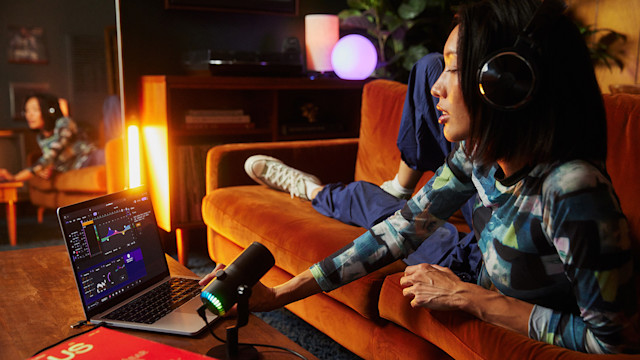Vocal Effects: Best Voice Effects And How To Use Them
May 2, 2024 - Unleash the power of vocal effects. Elevate your sound with advanced techniques and gear, and take your vocal production to the next level.

Vocal effects are an indispensable part of modern music production, transforming raw vocal tracks into polished, compelling components of a song.
Understanding and applying these effects can significantly improve the quality of your vocal production and the overall quality of your mix, whether you're aiming to achieve a natural, refined sound or an intentionally stylized one.
Many technologies have become staples in the toolkit of sound engineers and producers, enabling us to tweak the pitch and space around vocals to better suit the intended artistic vision.
I'm excited to share some fundamental approaches you can immediately apply in your production on how vocal effects can enhance your recordings or live performances. The use of effects like EQ, compression, and de-essing allows you to shape the clarity and dynamic range of the voice, ensuring it sits well within the mix.
Getting creative with effects such as delay, reverb, autotune, and vocoders can give your vocal tracks a distinct character that stands out.
Whether you're looking to gently polish your vocal production or boldly transform it into something new and captivating, the strategic use of vocal effects can open up a world of sonic possibilities.
Fundamentals of Vocal Effects
Vocal effects can enhance the quality and impact of the voice. These effects help achieve the right tone and style for your song and allow your vocals to blend well with the rest of the mix.
Understanding the Vocal Track
The vocal track is essentially the raw performance you record using a microphone. It's an unaltered human voice before any effects are applied.
In music production, it's important first to capture a clean and clear recording of the vocal performance to allow for the best application of effects.
Before we get into the details, my first piece of advice is that less is more. It's amazing how little audio effects and processing are actually needed to dial in the vocal sound.
Trust your ears, and when you're unsure, listen to some of your favorite song productions from the same genre you're working in and use their approach as your reference sound.
Clarity
Before adding effects, ensure that your vocal recording is clear without any unwanted noise or distortion.
Tonal Balance
The human voice has a wide range of frequencies; a well-balanced vocal track should have a good distribution across low, mid, and high frequencies.
Dynamics
Pay attention to your performance's dynamic range, which refers to the variation in loudness.
Smoothing out these dynamics by editing the vocal track's levels and using compression can make your vocals sit well in the mix.
Remember, the goal is to enhance your vocals to complement the overall production, not overshadowing the natural voice of the artist.
Essential Vocal Effects Gear for Live Performances
Having the right gear is crucial when you're looking to elevate the quality of your vocal performance.
Vocal Processors
Vocal processors are the go-to tools for enhancing vocal performances in real time. They offer a range of effects such as pitch correction, harmonizing, de-essing, and reverb, all designed to polish your vocal tracks to perfection.
One notable vocal processor unit is the TC Helicon Mic Mechanic, which provides high-quality, studio-grade reverbs and pitch correction in a compact, stage-ready unit.
Vocal Effects Pedals
For dynamic performance and hands-on control, vocal effects pedals are your allies. They allow you to switch effects on and off or tweak them during a live performance. These stompboxes can include effects like:
Distortion: For a gritty edge to your vocals.
Delay: To create an echo effect that can add rhythm and depth.
Looping: This is used to layer multiple vocal lines on top of each other in real time.
You can mix and match these effects using pedals to add character and variety to your performance.
Key Vocal Recording Gear for Music Production
High-Quality Microphone
In order to capture a pro studio quality sound, you'll need a high-end microphone. The good news is, there are plenty of affordable options that can give you that modern vocal sound.
The type of microphone you should choose depends largely on the style of music and the type of voice you'll be recording. A condenser mic is the most common type of microphone used in a pro studio.
However, there are also some great dynamic mic options that sometimes work well for a more intense performance, like rap vocals.
Audio Interfaces
Your audio interface is the critical link between your microphone and your computer. It converts the analog signal from your mic into a digital format that your recording software can use.
When choosing an audio interface, make sure it has high-quality preamps, as they ensure a clear and dynamic vocal recording.
Look for interfaces with low latency to avoid delay between your singing and what you hear back. Ensure the interface has the right connections for your microphones and outboard gear.
By getting a quality audio interface, you ensure that all the nuances of your vocal effects are captured with clarity.
Digital Audio Workstation
A digital audio workstation (DAW) is the central hub for your music production, offering tools for recording, editing, arranging, and mixing audio tracks to create a polished and professional final product.
You should choose a DAW that works well for your specific workflow and situation.
Soundtrap is a great option. It's completely online and accessible through your browser, making collaboration easy and effective.

Vocal Production Techniques and Effects
Achieving a professional sound involves both capturing a stellar vocal performance and refining it through mixing.
These tools can seem daunting if you're a beginner-level producer but don't worry. The basics are easy to learn.
In Sountrap, you can insert effects by selecting a track, then clicking on the Effects symbol on the right side of the screen.
There are some go-to effects to ensure vocals sit well within the mix:
EQ
Equalization can enhance your vocal production by allowing you to adjust the frequency balance, allowing for clarity, presence, and balance in a vocalist's sound within a mix.
Some basic eq adjustments, like a low-pass filter, can help clear up the voice.
Compression
Compression is a fundamental tool in vocal production. It normalizes the dynamic range and evens the vocal performance, ensuring that all parts of the performance are heard clearly.
Delay
Delay can help enrich the vocals by creating depth, dimension, and atmosphere, adding a sense of space and texture to the vocal performance. There are many types of delays that can work well for vocals, depending on the sound you're after.
Reverb
Reverb also adds space, creating the illusion of a vocalist performing in a physical environment, from tight rooms to large halls.
Try out the reverb plugin in Soundtrap. Once you have in on the track,
By investing in the right gear and understanding the fundamentals of vocal production, you can create professional-sounding tracks right from your home studio.
Advanced Techniques
Doubles & Harmonizing
Doubling vocals is a great way to add energy and depth to a section. If you pay attention closely you'll hear that many of your favorite songs feature doubles in the chorus section. If there's more than one double, they are typically panned fairly wide to left and right.
If you don't have double takes of the section where you want to use this approach, you can also use a Vocal Doubler plugin to achieve the sound. Soundtrap comes with an easy-to-use Vocal Doubler plugin; you can find it in the Effects section under Vocals.
Harmonies can help add layers and depth that complement the main melody.
To create 3-part harmonies, you can either record each harmony part separately or use a vocal harmonist plugin, which intelligently generates the harmonic parts based on your main vocal.
Both are great options, depending on your end goal sound. For a natural overall vocal sound that supports the lead vocal, you should record 3-part harmonies with the artist or backing singers.
For a more modern vocal effect, feel free to experiment with vocal harmony plugin settings. With these types of tools, your imagination is the limit!
Tuning
In today's music industry, pitch correction software is a key component of polished vocal sounds. It's the go-to tool for achieving a refined pitch-perfect performance without robotic artifacts.
When using pitch correction, subtle adjustments can maintain the natural vocal nuances while still correcting any off-notes.
Don't be afraid to experiment and go in with a heavy hand for a more creative effect! Sometimes, the coolest effects come out of experimenting.
De-Essing
De-essing is an important tool in producing a professional-quality vocal mix, as it mitigates the harsh "s" sounds and smooths out sibilances.
Same rule applies here as always - start with just a small amount and trust your ears. Once you hear the de-essing working a little too hard, dial it back a touch.
Parallel Compression
Parallel compression, also known as New York compression, is another technique that can help add density without over-compressing. It also helps enhance the body and tone of the vocals. It involves blending a heavily compressed version of a vocal track with the original, uncompressed signal. You can set up parallel compression by sending a duplicate of the vocal track to an aux bus with a compressor set to high compression settings and then blending it back into the mix. Listen carefully for the effect and adjust to taste.
This technique can help you achieve a fuller, more impactful vocal sound without sacrificing clarity or natural dynamics.
By learning these techniques, your vocal tracks can achieve technical precision and the expressive qualities that connect music with listeners.
Distortion
Sometimes, distortion on vocals can give you that edgy, high-energy sound.
Experiment with the different types of distortions your DAW has available. In Soundtrap, there's Clipper, Crusher and Juicy Distortion, all of which give you totally different results.
Check with your favorite reference song productions in your style and find the same distortion tone they used.
These advanced tools are not easy to master. My advice to you is to stay patient and take your time; practice and experimentation are key.
Managing Ambient Noise
You should manage your recording space's ambient noise and acoustics so the vocal recordings you're capturing are as clean as possible.
Noise Gates
Noise gates help to eliminate unwanted background noise when you're not singing. Adjust the threshold so that the gate closes during silences but doesn't cut off soft singing.
In-Ear Monitors for Live Performances
In-ear monitors are great for reducing stage noise and providing you with a clear mix. They also help the artist hear their performance better and stay on pitch.
Conclusion
We live in exciting times. In recent years we have witnessed remarkable developments in vocal effects, offering both seasoned professionals and newcomers innovative ways to craft captivating and unique vocal lines.
Harnessing the power of cutting-edge gear, effects and creative techniques can elevate your recordings from ordinary to pro level and help you find your own unique sound.
Whether you're looking to capture a vocal performer's raw emotion or use a creative palette of effects to deliver an artistic, modern vocal production, having the right tools and understanding how to use them are essential.
About the author
Tero Potila is a professional music composer and producer. His career combining knowledge and experience from music, TV, film, ad, and game industries gives him a unique perspective that he shares through posts on teropotila.com.
Get started with Soundtrap today!